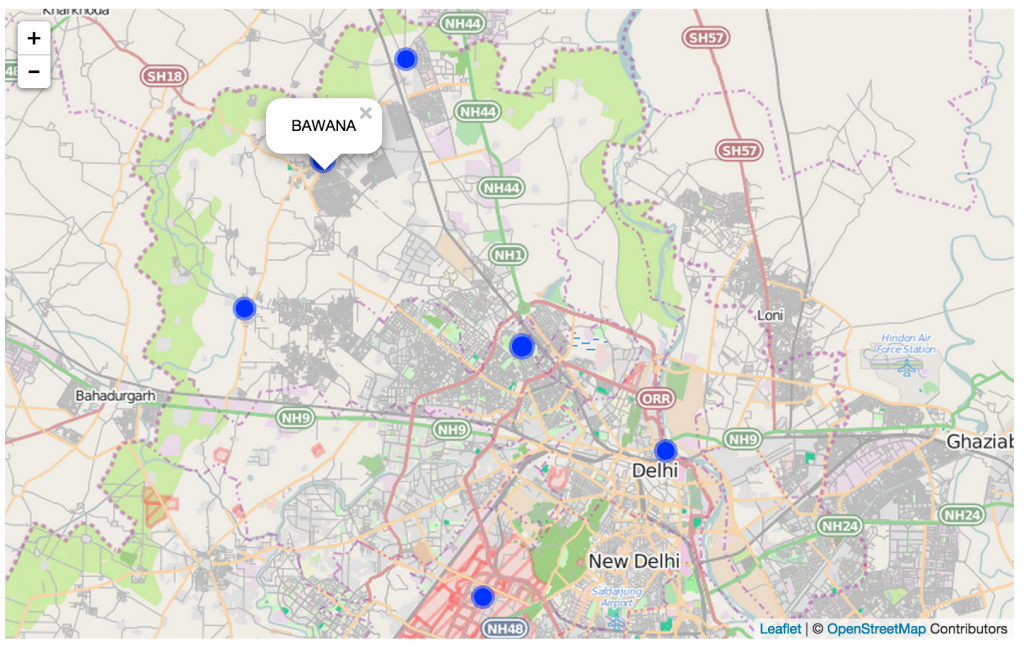Suppose you have a list of places and you’d like to plot them on an interactive map. The example below uses locations in Delhi, India.
Input:
SHALIMARBAGH DELHI, NARELA DELHI, KANJHAWALA DELHI, BAWANA, KASHMIRI GATE, NARAINA GOPINATH BAZAAR
What we’re aiming for:

The following guide uses code from the following tutorials:
- http://leafletjs.com/examples/quick-start.html
- http://www.d3noob.org/2014/02/adding-multiple-markers-to-leafletjs-map.html
1. Get corresponding latitude and longitude coordinates.
http://www.findlatitudeandlongitude.com/batch-geocode/
“original address”,latitude,longitude
“SHALIMARBAGH DELHI”,28.716413,77.154585
“NARELA DELHI”,28.85396,77.091784
“KANJHAWALA DELHI”,28.734729,77.004176
“BAWANA”,28.805465,77.046301
“KASHMIRI GATE”,28.666472,77.233289
“NARAINA GOPINATH BAZAAR”,28.596289,77.133865
2. Convert CSV (comma-separated values) output to JSON array
http://www.convertcsv.com/csv-to-json.htm
[
[“SHALIMARBAGH DELHI”,28.716413,77.154585 ],
[“NARELA DELHI”,28.85396,77.091784 ],
[“KANJHAWALA DELHI”,28.734729,77.004176 ],
[“BAWANA”,28.805465,77.046301 ],
[“KASHMIRI GATE”,28.666472,77.233289 ],
[“NARAINA GOPINATH BAZAAR”,28.596289,77.133865 ]
]
3. Copy-paste coordinates into existing template.
Code and map can be found on Plunker:
http://embed.plnkr.co/5gh2mknjC51C6BmdsFwo/preview
<!DOCTYPE html>
<html>
<head>
<title>Plotting Circles on a Map</title>
<meta charset=”utf-8″ />
<meta name=”viewport” content=”width=device-width, initial-scale=1.0″>
<link rel=”stylesheet” href=”http://cdn.leafletjs.com/leaflet-0.7.3/leaflet.css” />
</head>
<body>
<div id=”map” style=”width: 800px; height: 500px”></div>
<script src=”http://cdn.leafletjs.com/leaflet-0.7.3/leaflet.js”></script>
<script>
//Set the map center and zoom level
var map = L.map(‘map’).setView([28.7271309, 77.1480638], 11);
mapLink =
‘<a href=”http://openstreetmap.org”>OpenStreetMap</a>’;
L.tileLayer(
‘http://{s}.tile.openstreetmap.org/{z}/{x}/{y}.png’, {
attribution: ‘© ‘ + mapLink + ‘ Contributors’,
maxZoom: 18,
}).addTo(map);
//Add coordinates here
var planes1 = [
[“SHALIMARBAGH DELHI”,28.716413,77.154585 ],
[“NARELA DELHI”,28.85396,77.091784 ],
[“KANJHAWALA DELHI”,28.734729,77.004176 ],
[“BAWANA”,28.805465,77.046301 ],
[“KASHMIRI GATE”,28.666472,77.233289 ],
[“NARAINA GOPINATH BAZAAR”,28.596289,77.133865 ]
];
//Change the size and color of circular markers here
for (var i = 0; i < planes1.length; i++) {
circle = new L.circle([planes1[i][1],planes1[i][2]], 500, {
fillOpacity: 1.0
})
.bindPopup(planes1[i][0])
.addTo(map);
}
</script>
</body>
</html>
